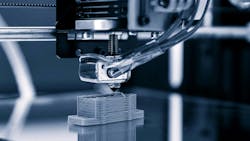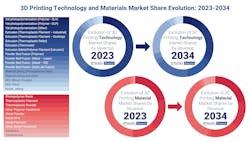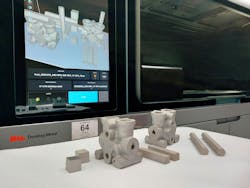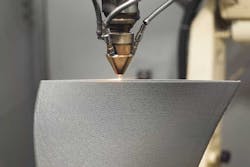The 3D printing market has expanded greatly over the past four decades as technological advancements and application uses have increased. Continued development of the technology and its growing use for prototyping, manufacturing and other applications will aid further market growth in the coming years.
Research firm IDTechEx is forecasting the 3D printing market will achieve a compound annual growth rate (CAGR) of 11% between 2024 and 2034, reaching a value of $49 billion. This will be generated by sales of 3D printers and printing materials.
Recent analysis from IDTechEx shows there are four major trends that will likely shape the 3D printing market in the coming years and contribute to its future growth potential.
1. Growth of Powder Bed-Based 3D Printing Technologies
One of the key drivers for the continued growth of 3D printing, also referred to as additive manufacturing (AM), will be finding the mid- to high-volume applications in which the technology can be used, said IDTechEx in its research.
According to the research firm, sand casting cores for mass production electric vehicles and casings for smartphones are some of the higher volume applications in which manufacturers are finding a viable use for 3D printing. IDTechEx said applications like these will require the use of powder-bed 3D printing technologies which are better able to meet their throughput requirements.
As such, it anticipates strong growth opportunities for powder bed-based printing technologies such as laser powder bed fusion and binder jetting. Laser powder bed fusion (L-PBF) uses heat, often from a laser, to fuse powdered material together and builds parts one layer at time, similar to other AM methods. It allows for use of various materials and enables the creation of strong, accurate and detailed parts which has made it a popular choice in industrial and commercial applications.
Binder jetting uses a powder-based material and a binder which is used as an adhesive between each powder layer to create parts. According to ExOne, a developer of binder jet 3D printers, this technology allows the production of high-value and one-of-a-kind parts.
During the International Fluid Power Exhibition (IFPE) 2023, Aidro Hydraulics & 3D Printing told Power & Motion it was starting to use binder jet 3D printing for its hydraulic and pneumatic components which would help with higher volume production parts. Later that year, the company received AM Manufacturer certification for its use of binder jetting and L-PBF which signals the quality of the products it is manufacturing with these technologies.
2. Industry Consolidation Necessary for Profitability
IDTechEx said it will be necessary for the 3D printing industry to consolidate to become more profitable. As the use of AM technology has grown, so too has the number of companies working in the sector, creating a high level of competition.
In the 3D printing hardware space alone there are currently 1,000 companies the research firm noted. While competition and variety are good, too much can make it difficult for companies to be profitable because money spent on 3D solutions is spread across so many companies within the sector.
Per IDTechEx’s analysis, challenging macro-economic conditions will likely make it more difficult to raise capital for business investments as well as minimize financial risk taking. This will place extra pressure on 3D printing companies to achieve profitability to ensure they can weather the economy.
The research firm said it will be necessary for more mergers, acquisitions and exits to occur, and at a faster pace, over the next several years to enable companies to become profitable.
In May 2023, the potential merger of Stratasys and Desktop Metal was announced which would have brought together two of the largest players in the 3D printing space. By combining their resources and expertise, the companies hoped to make AM technology a more attractive option to manufacturers while increasing their profitability. However, months later the deal was terminated by Stratasys stakeholders and it is seeking other options.
READ MORE about how the potential merger unfolded from Industry Week, an Endeavor Business Media partner site.
Following the terminated merger with Statasys, Desktop Metal is also working to improve its profitability. In January 2024, the company announced plans to take various actions to cut costs, stating they were necessary due to the current downturn in the additive manufacturing industry. While demand for this technology is soft, the company is positive about the long-term outlook for the 3D printing market.
3. Making 3D Printing More Sustainable
One of the benefits touted by AM is how it can aid sustainability efforts by reducing material use and waste. In addition, less machining is often required to create a final part which can help reduce energy use for a manufacturer.
However, IDTechEx said in its analysis the industry will likely go beyond this initial benefit and work to make the 3D printing process itself more sustainable as well. This will include more consideration of the energy sources used for printing technologies, which tend to be energy-intensive at the moment.
Incorporation of artificial intelligence-driven software into the supply chain is also likely to occur to reduce potential waste such as supports and prints with defects. The research firm sees there being innovations in recycled materials as well to help further cut down on waste for both low- and high-performance applications.
Mining equipment manufacturer Epiroc and steel manufacturer SSAB are working together to improve the sustainability of parts manufacturing using 3D printing. The companies are researching the potential of using SSAB’s fossil-free steel to help reduce the overall environmental impact of the 3D printing process by minimizing emissions from the manufacture of the steel and taking advantage of the benefits offered by AM.
In addition, the companies see opportunities to improve the design of components through the use of 3D printing. The first part they prototyped was a hydraulic block; flow through the block was improved and its weight reduced, both of which could lead to efficiency gains for end users of Epiroc’s mining equipment. More efficient machines mean less fuel used and emissions produced, offering additional sustainability benefits.
4. Development of Higher Performance Materials
3D printing materials are still an area in which development is needed and a barrier to adoption of additive manufacturing said IDTechEx. The number of materials which can now be used has grown over the years but remains limited compared to those used in well-established manufacturing methods.
There are several companies researching and developing materials for AM, including high-performance options designed specifically to meet the demands of various 3D printing sectors. High entropy alloys, nanocarbon reinforced composites and non-oxide ceramics are some of the materials noted by IDTechEx currently under development.
Most recently, Desktop Metal announced the expansion of its partnership with Evonik, a provider of 3D printing materials. Collaboration between the companies has enabled qualification of Evonik's INFINAM ST 6100 L, a high-strength photopolymer.
The material features an ultimate tensile strength of 90 MPa, flexural stress of 135 MPa, and heat deflection temperature (HDT) of 120 C. It is qualified for use with Desktop Metal's ETEC brand of Digital Light Processing (DLP) 3D printers. Evonik's material is suited for 3D printing of molds, models and tool as well as end-use parts for aerospace, automotive and electronics applications. Parts made from it can have precise features and a smooth surface finish to meet a variety of application requirements.
IDTechEx said developments in 3D printing materials will not only increase the number available which can be used for 3D printing but also expand the potential use cases for this manufacturing technology, benefiting its future growth potential.
About the Author
Sara Jensen
Executive Editor, Power & Motion
Sara Jensen is executive editor of Power & Motion, directing expanded coverage into the modern fluid power space, as well as mechatronic and smart technologies. She has over 15 years of publishing experience. Prior to Power & Motion she spent 11 years with a trade publication for engineers of heavy-duty equipment, the last 3 of which were as the editor and brand lead. Over the course of her time in the B2B industry, Sara has gained an extensive knowledge of various heavy-duty equipment industries — including construction, agriculture, mining and on-road trucks —along with the systems and market trends which impact them such as fluid power and electronic motion control technologies.
You can follow Sara and Power & Motion via the following social media handles:
X (formerly Twitter): @TechnlgyEditor and @PowerMotionTech
LinkedIn: @SaraJensen and @Power&Motion
Facebook: @PowerMotionTech





